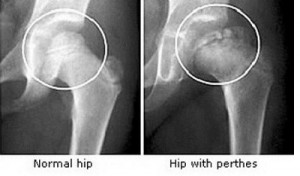What is Perthes disease?
Perthes disease, also known as Legg Calve Perthes disease, is the disease caused when the blood supply to the head of the femur is disturbed, this affects the hip joint, where the top of the femur (the thigh bone) meets the acetabulum, (the socket of the pelvis). This reduction in blood flow results in the bone softening and beginning to break down, this is known as avascular necrosis. This softening and breakdown of the bone causes the femoral head, the ball part of the ball and socket joint, to change shape and deform.
As the blood flow returns, one of the main complications during the re-growth phase is that the femur head does not form in a spherical shape as before.
The severity of deformity of the femoral head determines the degree of symptoms and if there are likely to be any future problems, such as, decreased range of motion at the joint or arthritis.
Who can be affected by Perthes disease?
Perthes disease most commonly affects children aged between 4 and 12, but occasionally can occur in younger children or in teenagers. Boys are far more likely to develop this condition than girls. Should girls be affected by Perthes disease they tend to suffer from more severe symptoms.
Symptoms
Perthes disease only affects hip joints but some children report pain in the knee, this is often a referred pain or due to changes in normal walking pattern. The child may have tiredness, pain in the groin area, stiffness and reduced range of motion at the hip which may cause them to walk with a limp. In some cases, the affected leg may appear shorter than the other.
The symptoms of Perthes disease are usually only present in one hip, although in some cases it can affect both.
Treatment
As with most conditions, early diagnosis is key to best management.
Pain in the knee or hip joints in children should always be looked at by a medical professional at the earliest opportunity. The therapists at Newcastle Sports Injury Clinic are skilled in the treatment of children & adolescents suffering with musculoskeletal injuries and will be able to assess the child, diagnose and if necessary arrange for X-rays or scans and advise on the most appropriate treatment plan for the child.
If the child is suspected of having Perthes disease, it is likely that an X-ray of the affected hip will be performed, however in the early stages of this condition an X-ray may appear normal and further investigations such as MRI scans may be required.
Treatment is aimed at maintaining mobility in the hip and promote healing in the correct position. Treatment methods vary depending upon the age of the child and the severity of the condition but in many cases, can be managed with relative rest and physiotherapist led rehabilitation. Other treatment options and surgery may be warranted but only in extreme cases.
As with any injury we would always recommend early diagnosis and starting on a treatment plan as soon as possible to speed up recovery and reduce the risk of requiring more complex or long-term treatments. Our therapists at Newcastle Sports Injury will always create a bespoke rehabilitation/treatment plan which is specifically designed to fit the needs of the patient.
For further information contact 0191 2330500 and one of our therapists will be happy to assist.


